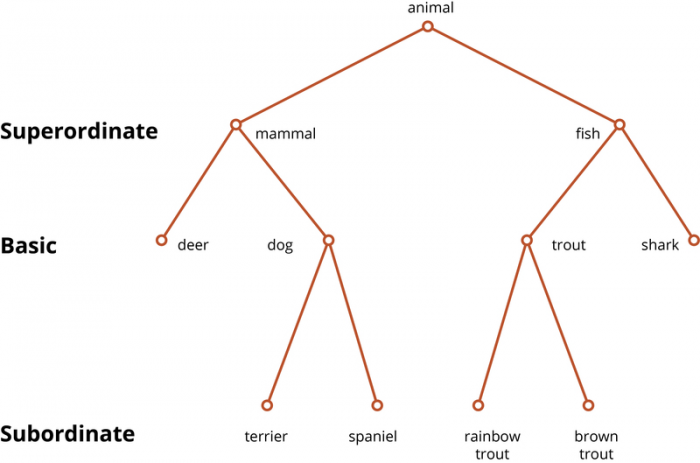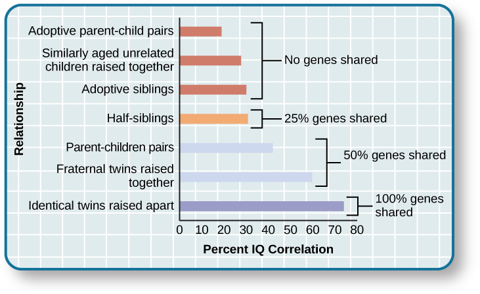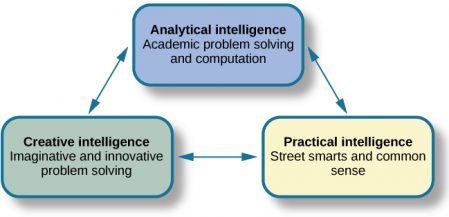Chapter 12: Cross-Cultural Cognition
L D Worthy; T Lavigne; and F Romero
Attention
Attention is the behavioral and cognitive process of selectively concentrating on one thing in our environment while ignoring other distractions. Attention is a limited resource. This means that your brain can only devote attention to a limited number of stimuli (things in the environment). Many aspects of attention have been studied in the field of psychology. In some respects, we define different types of attention by the nature of the task used to study it.
Culture can also influence and shape how we attend to the world around us. Masuda and Nisbett (2001) asked American and Japanese students to describe what they saw in images like the one shown below. They found that while both groups talked about the most salient objects (the fish, which were brightly colored and swimming around), the Japanese students also tended to talk and remember more about the images in the background (they remembered the frog and the plants as well as the fish).

North Americans and Western Europeans in these types of studies were more likely to pay attention to salient and central parts of the pictures, while Japanese, Chinese, and South Koreans were more likely to consider the context as a whole. The researchers described this as holistic perception and analytic perception.
Holistic Perception: A pattern or perception characterized by processing information as a whole. This pattern makes it more likely to pay attention to relationships among all elements. Holistic perception promotes holistic cognition: a tendency to understand the gist, the big idea, or the general meaning. Eastern medicine is traditionally holistic; it emphasizes health in general terms as the result of the connection and balance between mind, body, and spirit.
Analytic Perception: A pattern of perception characterized by processing information as a sum of the parts. Analytic perception promotes analytic thinking: a tendency to understand the parts and details of a system. This pattern makes it more likely to pay attention and remember salient, central, and individual elements. Western medicine is traditionally analytic; it emphasizes specialized subdisciplines and it focuses on individual symptoms and body parts.

How we attend and perceive our world has implications for how we evaluate and explain the world around us, including the actions of others. We will talk more about this concept, known as attributions, later in the chapter.
Social Cognition
The culture that we live in has a significant impact on the way we think about and perceive our social worlds, so it is not surprising that people in different cultures would think about people and things somewhat differently. Social cognitions are the way we think about others, pay attention to social information, and use the information in our lives (consciously or unconsciously). In this section we will review several types of social cognitions including schemas, attributions, confirmation bias and the fundamental attribution error. We will also examine culture’s influence on analytic perception and holistic perception.
Schema
Through the process of cognitive development, we accumulate a lot of knowledge and this knowledge is stored in the form of schemas, which are knowledge representations that include information about a person, group, or situation. Because they represent our past experience, and because past experience is useful for prediction, our schemas influence our expectations about future events and people.
When a schema is activated it brings to mind other related information. This process is usually unconscious, or happens outside of our awareness. Through schema activation, judgments are formed based on internal assumptions (bias) in addition to information actually available in the environment. When a schema is more accessible it can be activated more quickly and used in a particular situation. For example, if there is one female in a group of seven males, female gender schemas may be more accessible and influence the group’s thinking and behavior toward the female group member. Watching a scary movie late at night might increase the accessibility of frightening schemas, increasing the likelihood that a person will perceive shadows and background noises as potential threats.

Once they have developed, schemas influence our subsequent learning, such that the new people and situations we encounter are interpreted and understood in terms of our existing knowledge (Piaget & Inhelder, 1962; Taylor & Crocker, 1981). When existing schemas change on the basis of new information, we call the process accommodation. In other cases, however, we engage in assimilation, a process in which our existing knowledge influences new conflicting information to better fit with our existing knowledge, thus reducing the likelihood of schema change. You may remember these concepts from Chapter 4 when we learned about Piaget’s theory of cognitive development.
Psychologists have become increasingly interested in the influence of culture on social cognition and schemas. Although people of all cultures use schemas to understand the world, the content of our schemas has been found to differ for individuals based on their cultural upbringing. For example, one study interviewed a Scottish settler and a Bantu herdsman from Swaziland and compared their schemas about cattle. Because cattle are essential to the lifestyle of the Bantu people, the Bantu herdsman’s schemas for cattle were far more extensive than the schemas of the Scottish settler. The Bantu herdsmen were able to distinguish his cattle from dozens of others, while the Scottish settler was not.

One outcome of assimilation that shapes our schema is confirmation bias, the tendency for people to seek out and favor information that confirms their expectations and beliefs, which in turn can further help to explain the often, self-fulfilling nature of our schemas. The confirmation bias has been shown to occur in many contexts and groups, although there is some evidence of cultural differences in its extent and prevalence. Kastenmuller and colleagues (2010), for instance, found that the bias was stronger among people with individualist (e.g., the United States, Canada, and Australia) versus collectivist (e.g., Japan, China, Taiwan, Korea, India among others) cultural backgrounds. The researchers argued that this partly stemmed from collectivist cultures putting greater importance in being self-critical, which is less compatible with seeking out confirming as opposed to disconfirming evidence.
Attributions
Psychologists who study social cognition believe that behavior is the product of the situation (e.g., role, culture, other people around) and the person (e.g., temperament, personality, health, motivation). Attributions are beliefs that a person develops to explain human behaviors, characteristics and situations. This means that we try to explain or make conclusions about the causes of our own behavior and others’ behavior. Internal attributions are dispositional (e.g., traits, abilities, feelings), and external attributions are situational (e.g., things in the environment). Our attributions are frequently biased. One way that our attributions may be biased is that we are often too quick to attribute the behavior of other people to something personal about them rather than to something about their situation. This is a classic example of the general human tendency of underestimating how important the social situation really is in determining behavior. Fundamental attribution error (FAE) is the tendency to overestimate the degree to which the characteristics of an individual are the cause of an event, and to underestimate the involvement of situational factors. FAE is considered to be universal but that cultural differences may explain how and when FAE occurs.
Attributions and Culture
On average, people from individualistic cultures tend to focus their internal attributions more on the individual person, whereas, people from collectivistic cultures tend to focus more on the situation (Ji, Peng, & Nisbett, 2000; Lewis, Goto, & Kong, 2008; Maddux & Yuki, 2006). Miller (1984) asked children and adults in both India (a collectivistic culture) and the United States (an individualist culture) to indicate the causes of negative actions by other people. Although the younger children (ages 8 and 11) did not differ, the older children (age 15) and the adults did. Americans made more dispositional attributions, whereas Indians made more situational attributions for the same behavior.
Morris and his colleagues (Hong, Morris, Chiu, & Benet-Martínez, 2000) investigated the role of culture on person perception in a different way, by focusing on people who are bicultural (i.e., who have knowledge about two different cultures). In their research, they used high school students living in Hong Kong. Although traditional Chinese values are emphasized in Hong Kong, because Hong Kong was a British-administrated territory for more than a century, the students there are also enculturated with Western social beliefs and values.
Morris and his colleagues first randomly assigned the students to one of three priming conditions. Participants in the American culture priming condition saw pictures of American icons (such as the U.S. Capitol building and the American flag) and then wrote 10 sentences about American culture. Participants in the Chinese culture priming condition saw eight Chinese icons (such as a Chinese dragon and the Great Wall of China) and then wrote 10 sentences about Chinese culture. Finally, participants in the control condition saw pictures of natural landscapes and wrote 10 sentences about the landscapes.
Then participants in all conditions read a story about an overweight boy who was advised by a physician not to eat food with high sugar content. One day, he and his friends went to a buffet dinner where a delicious-looking cake was offered. Despite its high sugar content, he ate it. After reading the story, the participants were asked to indicate the extent to which the boy’s weight problem was caused by his personality (personal attribution) or by the situation (situational attribution). The students who had been primed with symbols about American culture gave relatively less weight to situational (rather than personal) factors in comparison with students who had been primed with symbols of Chinese culture.
In still another test of cultural differences in person perception, Kim and Markus (1999) analyzed the statements made by athletes and by the news media regarding the winners of medals in the 2000 and 2002 Olympic Games. They found that athletes in China described themselves more in terms of the situation (they talked about the importance of their coaches, their managers, and the spectators in helping them to do well), whereas American athletes (can you guess?) focused on themselves, emphasizing their own strength, determination, and focus.
Most people tend to use the same basic perception processes, but given the cultural differences in group interconnectedness (individualistic versus collectivist), as well as differences in attending (analytic versus holistic), it should come as no surprise that people who live in collectivistic cultures tend to show the fundamental attribution error less often than those from individualistic cultures, particularly when the situational causes of behavior are made salient (Choi, Nisbett, & Norenzayan, 1999). Bias attributions can lead to negative stereotyping and discrimination but being more aware of these cross-cultural differences in attribution may reduce cultural misunderstandings and misinterpreting behavior.
Thinking
The way we represent the world influences the degree of success we experience in our lives. For example, if we represent yellow traffic lights as the time to hit the accelerator, then the world might give us tickets, scares, or accidents. If we represent our diet as a way to maximize refined sugar intake, then we might wind up experiencing heart disease. Mental representations and intelligence go hand in hand. Some mental representations are more intelligent, because they are more adaptive and support outcomes such as well-being, safety, and success. In this section we are going to cover other elements of thinking like categorization, memory, and intelligence and how culture shapes these processes.
Categories and Concepts
The information we sense and perceive is continuously organized and reorganized into concepts that belong to categories. Most concepts cannot be strictly defined but are organized around the best examples or prototypes, which have the properties most common in the category or might be considered the ideal example of a category.
Concepts are at the core of intelligent behavior. We expect people to be able to know what to do in new situations and when confronting new objects. If you go into a new classroom and see chairs, a blackboard, a projector, and a screen, you know what these things are and how they will be used. You’ll sit on one of the chairs and expect the instructor to write on the blackboard or project something onto the screen. You’ll do this even if you have never seen any of these particular objects before, because you have concepts of classrooms, chairs, projectors, and so forth that tell you what they are and what you’re supposed to do with them.
Objects fall into many different categories, but there is usually a hierarchy to help us organize our mental representations.
- A concept at the superordinate level of categories is at the top of a taxonomy and it has a high degree of generality (e.g., animal, fruit).
- A concept at the basic level categories is found at the generic level which contains the most salient differences (e.g., dog, apple).
- A concept at the subordinate level of categories is specific and has little generality (e.g., Labrador retriever, Gala).

Brown (1958) noted that children use basic level categories when first learning language and superordinates are especially difficult for children to fully acquire. People are faster at identifying objects as members of basic-level categories (Rosch et al., 1976). Recent research suggests that there are different ways to learn and represent concepts and that they are accomplished by different neural systems. Using our earlier example of a classroom, if someone tells you a new fact about the projector, like it uses a halogen bulb, you are likely to extend this fact to other projectors you encounter. In short, concepts allow you to extend what you have learned about a limited number of objects to a potentially infinite set of events and possibilities.
Categorization and Culture
There are some universal categories like emotions, facial expressions, shape and color but culture can shape how we organize information. Chiu (1972) was the first to examine cultural differences in categorization using Chinese and American children. Participants were presented with three pictures (e.g., a tire, a car, and a bus), and were asked to group the two pictures they thought best belonged together. Participants were also asked to explain their choices (e.g., “Because they are both large”). Results showed that the Chinese children have a greater tendency to categorize by identifying relationships among the pictures but American children were more likely to categorize by identifying similarities among pictures.
Later research reported no cultural differences in categorization between Western and East Asian participants; however, among similarity categorizations the East Asian participants were more likely to make decisions on holistic aspects of the images and Western participants were more like to make decisions based on individual components of the images (Norenzayan, Smith, Jun Kim, and Nisbett, 2002). Cultural differences in categorizing were also found by Unworth, Sears and Pexman (2005) across three experiments; however, when the experiment task was timed there were differences in category selection. These results suggest that the nature (timed or untimed) of the categorization task determines the extent to which cultural differences are observed.
The results of these categorization studies seem to support the differences in thinking between individualist and collectivist cultures. Western cultures are more individualist and engage in more analytic thinking and East Asian cultures engage in more holistic thinking (Choi, Nisbett, & Smith, 1997; Masuda & Nisbett, 2001; Nisbett et al., 2001; Peng & Nisbett, 1999). You might remember from the earlier section that holistic thought is characterized by a focus on context and environmental factors so categorizing by relationships can be explained with referencing how objects relate to their environment. Analytic thought is characterized by the separation of an object from its context so categorizing by similarity means that objects can be separated into different groups. A major limitation with these studies is the emphasis on East Asian, specifically the use of Chinese participants and Western cultures. There have been no within culture replications using participants from other non-Asian collectivist cultures.
Memory
Memory is a single term that reflects a number of different abilities: holding information briefly while working with it (working memory), remembering episodes of one’s life and our general knowledge of facts of the world among other types.
The information processing model of memory is a useful way to represent how information from the world is integrated with the knowledge networks of information that already exist in our minds.

[Image by Educ320, https://commons.wikimedia.org/wiki/File:The_modal_model.png CC BY-SA]
Recall that memory failures can occur at any stage, leading to forgetting or to having false memories. The key to improving one’s memory is to improve processes of encoding and to use techniques that guarantee effective retrieval. Good encoding techniques include relating new information to what one already knows, forming mental images, and creating associations among information that needs to be remembered. The key to good retrieval is developing effective cues that will lead the person back to the encoded information. Classic mnemonic systems can greatly improve one’s memory abilities.
Memory and Culture
It should be obvious, after learning about episodic memory, that many of our memories are personal and unique to us but cultural psychologists and researchers have found that the average age of first memories varies up to two years between different cultures. Researchers believe that enculturation and cultural values influence childhood memories. For example, the way parents and other adults discuss, or don’t discuss, the events in children’s lives influences the way the children will later remember those events.
Mullen (1994) found that Asian and Asian-American undergraduates’ memories, on average, happened six months later than the Caucasian students’ memories. These results were repeated in a sample of native Korean participants, only this time the differences were even larger. The difference between Caucasian participants and native Korean participants was almost 16 months. Hayne (2000) also found that Asian adults’ first memories were later than Caucasians’ but Maori adults’ (native population from New Zealand) memories reached even further back to around age three. These results do not mean that Caucasians or Maoris have better memories than Asians but rather people have the types of memories that they need to get along well in the world they inhabit – memories exist within cultural context. For example, Maori culture is focused on personal history and stories to a greater degree than American culture and Asian culture. Differences in memory could also be explained by the values of individualistic and collectivist cultures. Individualistic cultures tend to be independently oriented with an emphasis on standing out and being unique. Interpersonal harmony and making the group work is the emphasis of collectivist cultures and the way in which people connect to each other is less often through sharing memories of personal events. In some cultures, personal memory isn’t nearly as important as it is to people from individualistic cultures.
Intelligence: Individual Differences in Cognition
Psychologists have long debated how to best conceptualize and measure intelligence (Sternberg, 2003). These questions include how many types of intelligence there are, the role of nature versus nurture in intelligence, how intelligence is represented in the brain, and the meaning of group differences in intelligence. The concept of intelligence relates to abstract thinking and that includes our abilities to acquire knowledge, to reason abstractly, to adapt to novel situations, and to benefit from instruction and experience (Gottfredson, 1997; Sternberg, 2003). The brain processes underlying intelligence are not completely understood, but current research has focused on four potential factors:
- Brain size
- Sensory ability
- Speed and efficiency of neural transmission
- Working memory capacity
There is some truth to the idea that smarter people have bigger brains. Studies that have measured brain volume using neuroimaging techniques find that larger brain size is correlated with intelligence (McDaniel, 2005), and intelligence has also been found to be correlated with the number of neurons in the brain and with the thickness of the cortex (Haier, 2004; Shaw et al., 2006). It is important to remember that these correlational findings do not mean that having more brain volume causes higher intelligence. It is possible that growing up in a stimulating environment that rewards thinking and learning may lead to greater brain growth (Garlick, 2003), and it is also possible that a third variable, such as better nutrition, causes both brain volume and intelligence.
There is some evidence that brains of more intelligent people operate more efficiently than the brains of people with less intelligence. Haier, Siegel, Tang, and Abel (1992) analyzed data showing that people who were more intelligent showed less brain activity than those with lower intelligence when they worked on a task. Researchers suggested that more intelligent brains need to use less capacity. Brains of more intelligent people also seem to operate faster than the brains of those who are less intelligent. Research has found that the speed with which people can perform simple tasks, like determining which of two lines is longer or quickly pressing one of eight buttons that is lighted, was predictive of intelligence (Deary, Der, & Ford, 2001). Intelligence scores also correlate at about r = .5 with measures of working memory (Ackerman, Beier, & Boyle, 2005), and working memory is now used as a measure of intelligence on many tests.
Research using twin and adoption studies found that intelligence has both genetic and environmental causes (Neisser et al., 1996; Plomin, DeFries, Craig, & McGuffin, 2003). It appears that 40% – 80% of the variability (difference) in intelligence is due to genetics (Plomin & Spinath, 2004). The intelligence of identical twins correlates very highly at r = .86, which is much higher than the scores of fraternal twins who are less genetically similar (r = .60). Correlations between the intelligence of parents and their biological children (r = .42) is significantly higher than the correlation between parents and adopted children (r = .19). The intelligence of very young children (less than 3 years old) does not predict adult intelligence but by age 7 intelligence scores (as measured by a standard test) remain very stable in adulthood (Deary, Whiteman, Starr, Whalley, & Fox, 2004).

There is also strong evidence for the role of nurture, which indicates that individuals are not born with fixed, unchangeable levels of intelligence. Twins raised together in the same home have more similar intelligence scores than do twins who are raised in different homes, and fraternal twins have more similar intelligence scores than do non-twin siblings, which is likely due to the fact that they are treated more similarly than are siblings. Additionally, intelligence becomes more stable as we get older which provides evidence that early environmental experiences matter more than later ones.
Environmental factors also explain a greater proportion of the variance in intelligence and social and economic deprivation can adversely affect intelligence. Children from households in poverty have lower intelligence scores than children from households with more resources even when other factors such as education, race, and parenting are controlled (Brooks-Gunn & Duncan, 1997). Poverty may contribute to diets that undernourished the brain or lack appropriate vitamins. Poor children are more likely to be exposed to toxins such as lead in drinking water, dust, or paint chips (Bellinger & Needleman, 2003). Both of these factors can slow brain development and reduce intelligence.
Intelligence is improved by education and the number of years a person has spent in school correlates about r = .6 with intelligence (Ceci, 1991). There is a word of caution when interpreting this result. The correlation may be due to the fact that people with higher intelligence scores enjoy taking classes more than people with low intelligence scores, and may be more likely to stay in school. Children’s intelligence scores tend to drop significantly during summer vacations (Huttenlocher, Levine, & Vevea, 1998), a finding that suggests a causal effect of intelligence and education. A longer school year, as is used in Europe and East Asia, may be beneficial for maintaining intelligence scores for school-aged children.
One or Many
As learned earlier, intelligence is associated with the brain, includes abstract thinking, adapting to new situations, ability to benefit from instruction and experience (Gottfredson, 1997; Sternberg, 2003) and is largely determined by genetics. Psychologist Charles Spearman (1863–1945) hypothesized that there must be a single underlying construct that links these concepts, abilities and skills together. He called this construct the general intelligence factor (g) and there is strong empirical support for a single dimension to intelligence. Others psychologists believe that instead of a single factor, intelligence is a collection of distinct abilities. Raymond Cattell proposed a theory of intelligence that divided general intelligence into two components: crystallized intelligence and fluid intelligence (Cattell, 1963).
Crystallized intelligence is characterized as acquired knowledge and the ability to retrieve it. When you learn, remember, and recall information, you are using crystallized intelligence. You use crystallized intelligence all the time in your coursework by demonstrating that you have mastered the information covered in the course.
Fluid intelligence encompasses the ability to see complex relationships and solve problems. Navigating your way home after being detoured onto an unfamiliar route because of road construction would draw upon your fluid intelligence. Fluid intelligence helps you tackle complex, abstract challenges in your daily life, whereas crystallized intelligence helps you overcome concrete, straightforward problems (Cattell, 1963).
Robert Sternberg developed another theory of intelligence, which he titled the triarchic theory of intelligence because he proposed that intelligence is comprised of three parts (Sternberg, 1988): creative, analytical, and practical intelligence. (CAP).
- Creative intelligence is marked by inventing or imagining a solution to a problem or situation. Creativity in this realm can include finding a novel solution to an unexpected problem or producing a beautiful work of art or a well-developed short story.
- Analytical intelligence is closely aligned with academic problem solving and computations. Sternberg says that analytical intelligence is demonstrated by an ability to analyze, evaluate, judge, compare, and contrast. For example, in a science course such as anatomy, you must study the processes by which the body uses various minerals in different human systems. In developing an understanding of this topic, you are using analytical intelligence.
- Practical intelligence is sometimes compared to “street smarts.” Being practical means you find solutions that work in your everyday life by applying knowledge based on your experiences.

Multiple Intelligences Theory was developed by Howard Gardner and asserts that everybody possesses at least eight distinct types of intelligence. Among these eight intelligences, a person typically excels in some and falters in others (Gardner, 1983). Gardner’s theory is relatively new and needs additional research to establish empirical support. At the same time, his ideas challenge the traditional idea of intelligence to include a wider variety of abilities but creating a test to measure all of Gardner’s intelligences has been extremely difficult (Furnham, 2009; Gardner & Moran, 2006; Klein, 1997).
Intelligence and Culture
Intelligence can also have different meanings and values in different cultures. If you live on a small island, where most people get their food by fishing from boats, it would be important to know how to fish and how to repair a boat. If you were an exceptional angler, your peers would probably consider you intelligent. If you were also skilled at repairing boats, your intelligence might be known across the whole island. In Irish families, hospitality and telling an entertaining story are marks of the culture. If you are a skilled storyteller, other members of Irish culture are likely to consider you intelligent. Some cultures place a high value on working together as a collective. In these cultures, the importance of the group supersedes the importance of individual achievement. When you visit such a culture, how well you relate to the values of that culture exemplifies your cultural intelligence, sometimes referred to as cultural competence.
Intelligence Tests
Reliable intelligence testing began in the early 1900s with researchers named Alfred Binet and Henri Simon. They were instructed by the French government to develop an intelligence test to use on children in order to determine which ones might have difficulty in school. The test included many verbally based tasks. American researchers soon realized the value of such testing and Louis (Lewis) Terman, a Stanford professor, modified Binet’s work by standardizing the administration of the test, which was standardized by testing thousands of different-aged children in the United States to establish an average score for each age group. The Stanford-Binet, is a measure of general intelligence made up of a wide variety of tasks including vocabulary, memory for pictures, and naming of familiar objects and is primarily used with children.
Later, David Wechsler created an adult intelligence test named the Wechsler Adult intelligence Scale (WAIS), which is the most widely used intelligence test for adults (Watkins, Campbell, Nieberding, & Hallmark, 1995). The current version of the WAIS, consists of 15 different tasks including working memory, arithmetic ability, spatial ability, and general knowledge about the world. These 15 tasks measure a dimension of intelligence and provide psychologists with four domains scores: verbal, perceptual, working memory, and processing speed. The WAIS is highly correlated with the Stanford-Binet, as well as with criteria of academic and life success, including college grades, measures of work performance, and occupational level. It also shows significant correlations with measures of everyday functioning among individuals with intellectual disabilities.
Conclusion
We learned earlier in the chapter that the brain is central to sensing and perceiving our world but culture is at the heart of thinking. Culture shapes how we perceive information, evaluate the information and use the information in our daily life.
We organize the world into networks of information that are stored and used to interpret new experiences. This knowledge can be represented into hierarchical concepts with superordinate, basic, and subordinate categories. We hold information in short-term memory and process it using networks of information in long term memory; some from episodic experiences and some from more formal semantic knowledge. Intelligence is among the oldest and longest studied topics in all of psychology. The development of assessments to measure this concept is at the core of the development of psychological science itself. The way we perceive, remember, and think about the world we live in is influenced by our culture.
Vocabulary
Accommodation is a cognitive adaptation that occurs when schemas must change when new information is presented
Analytic Perception: A pattern of perception characterized by processing information as a sum of the parts. Analytic perception promotes analytic thinking.
Assimilation is a cognitive process that occurs when we change information in order to make it fit within our schema; with this conflict schema is less likely to change
Attention is the process of filtering information from sensation into perception and cognition.
Basic level categories is found at the generic level which contains the most salient differences (e.g., dog, apple).
Bottom-up perception occurs when we build up to perception from the individual pieces.
Categories are formed when concepts are ranked as subordinate, basic and superordinate levels
Concepts refer to information that is later organized and categorized
Confirmation bias is the tendency to seek out information that favors or confirms existing beliefs and expectations; outcome of assimilation
Crystallized intelligence is characterized as acquired knowledge and the ability to retrieve it.
Culture-Fair Test is an approach to measure intelligence that, in theory, intends to test intelligence in an equally fair way across all cultural groups. Fairness indicates a lack of bias in the assessment, interpretation, and use of data obtained from these measurements.
Dispositional attribution is an explanation of people’s behavior as a result of internal factors that reside within.
Encoding input of information into the memory system
Episodic memory is a type of long-term memory about events taking place at a specific time and place in a person’s life.
Fluid intelligence encompasses the ability to see complex relationships and solve problems.
Fundamental Attribution Error (FAE) is a bias that makes individuals incorrectly label others. Their behavior is attributed to set negative personal flaws. This error makes individuals underestimate the role of external factors
G-Factor is the notion that intelligence is a singular underlying cognitive aptitude or intellectual ability that is representative of a person’s general intellectual potential.
Holistic Perception: A pattern or perception characterized by processing information as a whole. This pattern makes it more likely to pay attention to relationships among all elements.
Intelligence Quotient (IQ) is a total score that is derived from a standardized test of intelligence. Historically, an IQ score is calculated by dividing a person’s mental age (MA) by the person’s chronological age (CA) and multiplying by 100 to avoid decimals. Thus, the formula: IQ=(MA/CA) X100.
Long-Term memory is the part of the memory system in which information can be permanently stored for an extended period of time. It has a large to unlimited capacity and a duration that may last from minutes to a lifetime.
Memory is a system or process that stores what we learn for future use and refers to lots of different abilities
Multiple intelligences is the notion that there is not a singular underlying general intelligence. According to this theory all people vary in terms of levels of strength across a diverse group of specific domains that expand beyond cognitive domains
Perception is the process of organizing or interpreting sensory information into awareness.
Perceptual Illusions is a subjective misinterpretation of sensory stimuli from its objective nature.
Schema are knowledge representations that include information about people, groups or situations; when activated schemas are useful for making predictions and decisions.
Semantic memory is the type of long-term memory about general facts, ideas, or concepts that are not associated to emotions and personal experience.
Sensation is the process that allows energy from the world to be translated as neural signals through the five senses: vision, hearing, taste, smell, and touch.
Sensory memory storage of brief sensory events, such as sights, sounds, and tastes
Short-Term memory is the part of the memory system in which information can be temporarily stored in the present state of awareness. This type of memory is limited to 7 items of capacity and 7 to 30 seconds of duration on average.
Storage is the creation of a permanent record of information
Superordinate level of categories is at the top of a taxonomy and it has a high degree of generality (e.g., animal, fruit).
Subordinate level of categories is specific degree and has little generality (e.g., Labrador retriever, Gala).
Top-down processing occurs when something that we’ve experienced in our past influences how we process new experiences.
